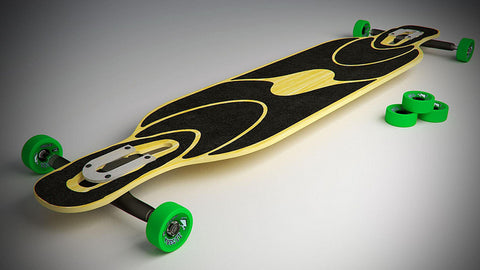The Long And Short Of Longboard Design

If you've ever REALLY looked at the longboards you see on the street, you've probably noticed a ton of variance. Why are some longboards super flexible? Why are some of them shaped differently?
We're here to break down the longboard design code, so you can understand what you're seeing--and find the right design for you.
BOARD SHAPES
Directional
Any kind of board where the front looks different from the back is a directional board. They're just supposed to go forward. You tend to use directional boards as cruisers, carvers, and downhill boards.
The most famous directional board shape is a pintail--it looks a little bit like a surfboard. Its base center is wider, and is sharply pointed on both ends, which gives the board a fluid balance.

The fishtail is another type of directional board, and it's similar to the pintail. Instead, imagine a pintail with 1/3 cut off the bottom, and a split tail in its place. A bunch of people use fishtails as cruisers, and fishtails tend to come with a kicktail that helps with turns.

The final directional shape we'll talk about is the blunt shape. It's longer and thinner than the pintail, and has a wider and rounder nose.

Symmetrical
So if directional boards are meant to just go forward, symmetrical boards can go just about anywhere, right? Yes. If you're a freestyle longboarder, and you see some 180° slides in your future, you'll want to step away from the directional boards and into symmetry-land.
The most common symmetrical board is the twin--a board introduced in the '90s specifically for multi-directional street skating. These longboards tend to be wide and stable, and incredibly versatile.

DECK STYLES
Top Mount
Top mount is traditional, simple, and inexpensive. Basically, the deck is mounted on top of the trucks, giving the board a little less stability but a lot more versatility than other mount styles.

Drop Through
Drop through boards are lower than top mount boards, because the trucks are mounted through the board. In other words, spaces for the trucks are carved out of the bottom of the board, lowering the deck by its thickness and increasing stability in spades.
Because you don't have to reach so far to brake or push, you get to ride with less fatigue, which makes this a great style for commuters.
Double Drop
A double drop deck takes drop through trucks and pairs them with board cutouts, so it's incredibly, ridiculously low to the ground. This style is very stable, but can also be pretty expensive, because it's tricky to build. You usually only find this on boards meant for downhill riding alone.

BOARD SHAPE FEATURES
Kick tail
Kick tails are usually found on skateboards (as shown in the picture below). They let you lift one end of the board off the ground for tricks, turns, and more--and a kick tail on a longboard lets you do the exact same thing.

Wheel Well
If you're a longboarder, you've probably experienced wheel bite--when you turn so hard your wheels smash into your deck and you smash into the ground. Some longboards prevent this with board cutouts (so your wheels can't possibly make contact) or wheel wells (so your wheels are discouraged from making contact).
BOARD BEND
This is different from board flex, which we'll go over in a second. Concave--or the bend of your board across its width--comes in four main varieties, all with their own benefits and drawbacks.
-
Flat no-concave
This style is, well, flat as a board. There's not a lot of big, fancy toe-heel energy transfer. It's good if you want to dance on your board, but if you're looking for speed and grip, you'll want to look elsewhere.
-
Radial concave (taco)
This has a smooth balance of toe-heel energy transfer, and it's also the most common concave style you'll find. The slight dip in the middle also gives your feet a good place to lock in when you're sliding.
-
Elliptical concave
Boards with elliptical concave are not too far from radial, but turn a little more sharply.
-
W-concave
Imagine putting two radial concaves on the same deck, and you get a W-shape--like the W-deck. This wild shape gives you even more toe-heel energy transfer, and lets you turn very quickly and very precisely.
BOARD FLEX
Boards can flex in a variety of ways. You'll want to look out for:
Longitudinal Flex
This is the bend from your board's nose to its tail. More flex means deeper carves.
Lateral Flex
This is the bend across your board's width--concave styles can have an effect on this.
Torsional Flex
This is the combination you get from your board's special mix of longitudinal and lateral flex. What happens when both are working at the same time?
Now that you know WHERE your board can flex, let's look at how it can flex:
Soft flex
These soft-flexing boards absorb shock really well, especially if you're riding over rough stuff. If you're looking for chill out and cruise, soft flex boards are fine. If you're planning on speed, watch out--soft boards get unstable at high speeds.
Medium flex
A classic medium anything--not too hot, not too cold. Medium-flex boards also have good shock absorption, and a little more stability than soft-flex boards. They're also springy and highly versatile.
Stiff flex
You really only want a stiff board if you're going FAST and you're going there NOW. Stiff boards give you little to no shock absorption, and they're most useful for dedicated downhill boards or super-fast freeriding.
Readers--what do you think? Let us know in the comments!
Further reading:
http://www.evo.com/guides/how-to-buy-longboards-deck-shape-style
https://www.windwardboardshop.com/learn/understanding-longboard-decks/
https://longboardbrand.com/types-of-longboards-explained-in-detail/
Photo credit: Christoffer Engstrom//Steven Erdmanczyk Jr//Peter Pearson//Longboards USA//Steve Watkins//erik forsberg//Bruno Alberto//Skateboard Stock Photo//Landyachtz Bomber
